 Students prepare to release tiny horseshoe crabs in Shui Hau, on Lantau Island
Students prepare to release tiny horseshoe crabs in Shui Hau, on Lantau IslandEven though its well-engineered body, protected by a single shell, has hardly changed over eons, the sea creature is being challenged by coastal developments, marine pollution and trawling.
In Hong Kong, the numbers of the crabs, which live on soft, muddy, sandy shores in and around shallow ocean waters, have plunged by more than 90per cent in the past decade alone. But it's not too late to turn the situation around.
For the past three years, teenagers have released into the wild more than 1,000 young Chinese horseshoe crabs bred in captivity by scientists at City University and reared at secondary schools.
The project, organised by the university and Ocean Park Conservation Foundation, has helped survival rates of the sea creature to increase from less than 0.01 per cent in the wild to 76.2per cent under the care of youngsters.
"It's amazing to watch the horseshoe crabs grow larger every time they moult," says Dorian Lam, 16, who is one of 700 students participating this year. He helped return the animals to one of their natural habitats in Shui Hau, on Lantau Island, earlier this month.
"When we first started to look after them at our school's laboratory in February, they were only a centimetre long," he said. "Today they have tripled in size. I hope the next time we visit this mudflat they'll be even larger and healthier."
Adult horseshoe crabs can be 60 centimetres long from head to tail.
When the programme started in 2011, only 16.5 per cent of horseshoe crabs given to students survived. But as schools have gained more experience, four times as many crabs have remained healthy enough to be freed.
Island School students said the secret to this is maintaining the ideal salinity, pH level, temperature and cleanliness of the water in which the crabs are kept.
"When it's too hot, water will evaporate and the salinity will rise," Jeanie Mak, 17, says. "We have to always keep an eye on the readings and add tap water when necessary."
Some of the horseshoe crabs released
Scientists have yet to determine whether the project has helped boost the ailing population over the long term.
Only horseshoe crabs that measured longer than 3.5centimetres were tagged with an electronic chip like an identity card. Yet without sufficient financial support, the chip cannot support GPS tracking, so scientists and volunteers have to comb the sites regularly to check on tagged crabs.
"The ancient creatures divide their 20-year lifespan between the mudflats [their nursery grounds] and the sea [where they head to when mature]," says Cheung Siu-kin, a biologist at CityU. "Will they stay in Hong Kong waters, or head to the South China Sea? Divers have seen them in Sai Kung and Tuen Mun. We need to systematically map the health and daily range of released crabs."
The project has raised public awareness of the horseshoe crabs' plight, says Joe Cheung Ho-yi, an education officer at the foundation.
Student participants cleaned rubbish left on the mudflats before releasing the crabs. "Now they know the consequences of littering the beaches," Cheung says. "It damages the health of horseshoe crabs, which they've painstakingly raised for six months, and pollutes their habitat."
At Island School, students raised about HK$2,000 from bake sales and laboratory tours to buy 26adult horseshoe crabs at a wet market in North Point; they were released in the sea near Sai Kung.
Po Leung Kuk Laws Foundation College published a book about students' experiences of rearing crabs, and shared these stories at conferences in Indonesia, Singapore and Jilin.
You might also like:
- How Miru the walrus found a new home and possibly love in Ocean Park
